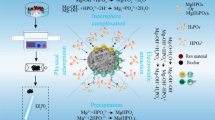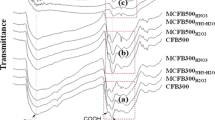Abstract
Biochar has emerged as a universal sorbent for the removal of contaminants from water and soil. However, its efficiency is lower than that of commercially available sorbents. Engineering biochar by chemical modification may improve its sorption efficiency. In this study, conocarpus green waste was chemically modified with magnesium and iron oxides and then subjected to thermal pyrolysis to produce biochar. These chemically modified biochars were tested for NO3 removal efficiency from aqueous solutions in batch sorption isothermal and kinetic experiments. The results revealed that MgO-biochar outperformed other biochars with a maximum NO3 sorption capacity of 45.36 mmol kg−1 predicted by the Langmuir sorption model. The kinetics data were well described by the Type 1 pseudo-second-order model, indicating chemisorption as the dominating mechanism of NO3 sorption onto biochars. Greater efficiency of MgO-biochar was related to its high specific surface area (391.8 m2 g−1) and formation of strong ionic complexes with NO3. At an initial pH of 2, more than 89 % NO3 removal efficiency was observed for all of the biochars. We conclude that chemical modification can alter the surface chemistry of biochar, thereby leading to enhanced sorption capacity compared with simple biochar.






Similar content being viewed by others
References
Ahmad, M., Lee, S. S., Dou, X., Mohan, D., Sung, J. K., Yang, J. E., & Ok, Y. S. (2012). Effects of pyrolysis temperature on soybean stover- and peanut shell-derived biochar properties and TCE adsorption in water. Bioresource Technology, 118, 536–544.
Ahmad, M., Lee, S. S., Oh, S. E., Mohan, D., Moon, D. H., Lee, Y. H., & Ok, Y. S. (2013a). Modeling adsorption kinetics of trichloroethylene onto biochars derived from soybean stover and peanut shell wastes. Environmental Science and Pollution Research, 20, 8364–8373.
Ahmad, M., Lee, S. S., Rajapaksha, A. U., Vithanage, M., Zhang, M., Cho, J. S., et al. (2013b). Trichloroethylene adsorption by pine needle biochar produced at various pyrolysis temperatures. Bioresource Technology, 143, 615–622.
Ahmad, M., Rajapaksha, A. U., Lim, J. E., Zhang, M., Bolan, N., Mohan, D., et al. (2014a). Biochar as a sorbent for contaminant management in soil and water: A review. Chemosphere, 99, 19–33.
Ahmad, M., Vithanage, M., Kim, K., Cho, J. S., Lee, Y. H., Joo, Y. K., et al. (2014b). Inhibitory effect of veterinary antibiotics on denitrification in groundwater: A microcosm approach. The Scientific World Journal. ID: 879831. doi:10.1155/2014/879831.
Al-Wabel, M. I., Al-Omran, A., El-Naggar, A. H., Nadeem, M., & Usman, A. R. A. (2013). Pyrolysis temperature induced changes in characteristics and chemical composition of biochar produced from conocarpus waste. Bioresource Technology, 131, 374–379.
Aly, A. A., Hasan, Y. N. Y., & Al-Farraj, A. S. (2014). Olive mill wastewater treatment using a simple zeolite-based low-cost method. Journal of Environmental Management, 145, 341–348.
Bagherifam, F., Komarneni, S., Lakzian, A., Fotovat, A., Khorasani, R., Huang, W., et al. (2014). Highly selective removal of nitrate and perchlorate by organoclay. Applied Clay Science, 95, 126–132.
Camargo, J. A., Alonso, A., & Salamanca, A. (2005). Nitrate toxicity to aquatic animals: A review with new data for freshwater invertebrates. Chemosphere, 58, 1255–1267.
Chen, B., Chen, Z., & Lv, S. (2011). A novel magnetic biochar efficiently sorbs organic pollutants and phosphate. Bioresource Technology, 102, 716–723.
Coates, J. (2000). Interpretation of infrared spectra, a practical approach. In R. A. Meyers (Ed.), Encyclopedia of analytical chemistry (pp. 10815–10837). Chichester: Wiley.
Dogan, M., Alkan, M., & Onganer, Y. (2000). Adsorption of methylene blue from aqueous solution onto perlite. Water, Air, and Soil Pollution, 120, 229–248.
Downie, A., Crosky, A., & Munroe, P. (2009). Physical properties of biochar. In J. Lehmann & S. Joseph (Eds.), Biochar for environmental management science and technology (pp. 13–32). London: Earthscans.
Jackson, M. L. (1973). Soil chemical analysis. New Delhi: Prentice Hall of India Pvt. Ltd.
**g, X. R., Wang, Y. Y., Liu, W. J., Wang, Y. K., & Jiang, H. (2014). Enhanced adsorption performance of tetracycline in aqueous solutions by methanol-modified biochar. Chemical Engineering Journal, 248, 168–174.
Kassaee, M. Z., Motamedi, E., Mikhak, A., & Rahnemaie, R. (2011). Nitrate removal from water using iron nanoparticles produced by arc discharge vs. reduction. Chemical Engineering Journal, 166, 490–495.
Keshavarzi, B., Moore, F., Najmeddin, A., Rahmani, F., & Malekzadeh, A. (2012). Quality of drinking water and high incidence rate of esophageal cancer in Golestan province of Iran: A probable link. Environmental Geochemistry and Health, 34, 15–26.
Khadka, P., Ro, J., Kim, H., Kim, I., Kim, J. T., Kim, H., et al. (2014). Pharmaceutical particle technologies: An approach to improve drug solubility, dissolution and bioavailability. Asian Journal of Pharmaceutical Sciences,. doi:10.1016/j.ajps.2014.05.005.
Lehmann, J., & Joseph, S. (2009). Biochar for environmental management: An introduction. In J. Lehmann & S. Joseph (Eds.), Biochar for environmental management science and technology (pp. 1–12). London: Earthscans.
Liu, B., Ray, A. S., & Thomas, P. S. (2007). Strength development in autoclaved aluminosilicate rich industrial waste-cement systems containing reactive magnesia. Journal of Australian Ceramics Society, 43, 82–87.
Liu, C. W., Lin, C. N., Jang, C. S., Ling, M. P., & Tsai, J. W. (2011). Assessing nitrate contamination and its potential health risk of Kinmen residents. Environmental Geochemistry and Health, 33, 503–514.
Loni, O. A., Zaidi, F. K., Alhumimidi, M. S., Alharbi, O. A., Hussein, M. T., Dafalla, M., et al. (2014). Evaluation of groundwater quality in an evaporation dominant arid environment: A case study from Al Asyah area in Saudi Arabia. Arabian Journal of Geosciences,. doi:10.1007/s12517-014-1623-4.
Ma, Y., Liu, W. J., Zhang, N., Li, Y. S., Jiang, H., & Sheng, G. P. (2014). Polyethylene amine modified biochar adsorbent for hexavalent chromium removal from the aqueous solution. Bioresource Technology, 169, 403–408.
Manning, B. A., & Goldberg, S. (1996). Modeling competitive adsorption of arsenate with phosphate and molybdate on oxide minerals. Soil Science Society of America Journal, 60, 121–131.
Mayer, Z. A., Eltom, Y., Stennett, D., Schroder, E., Apfelbacher, A., & Hornung, A. (2014). Characterization of engineered biochar for soil management. Environmental Progress and Sustainable Energy, 33, 490–496.
Mohan, D., Kumar, H., Sarswat, A., Franco, M. A., & Pitmann, C. U, Jr. (2014). Cadmium and lead remediation using magnetic oak wood and oak bark fast pyrolysis bio-chars. Chemical Engineering Journal, 236, 513–528.
Öztürk, N., & Bektas, T. E. (2004). Nitrate removal from aqueous solution by adsorption onto various materials. Journal of Hazardous Materials, 112, 155–162.
Plazinski, W., Rudzinski, W., & Plazinska, A. (2009). Theoretical models of sorption kinetics including a surface reaction mechanism: A review. Advances in Colloid and Interface Science, 152, 2–13.
Rajapaksha, A. U., Vithanage, M., Zhang, M., Ahmad, M., Mohan, D., Chang, S. X., & Ok, Y. S. (2014). Pyrolysis condition affected sulfamethazine sorption by tea waste biochars. Bioresource Technology, 166, 303–308.
Rodríguez-Marotoet, J. M., García-Herruzo, F., García-Rubio, A., Gomez-Lahoz, C., & Vareda-Alonso, C. (2009). Kinetics of the chemical reduction of nitrate by zero-valent iron. Chemosphere, 74, 804–809.
Shackley, S., Hammond, J., Gaunt, J., & Ibarrola, R. (2011). The feasibility and costs of biochar deployment in the UK. Carbon Management, 2, 335–356.
Sowmya, A., & Meenakshi, S. (2014). Effective removal of nitrate and phosphate anions from aqueous solutions using functionalised chitosan beads. Desalination and Water Treatment, 52, 2583–2593.
Usman, A. R. A., Sallam, A. S., Al-Omran, A., El-Naggar, A. H., Alenazi, K. K. H., Nadeem, M., & Al-Wabel, M. I. (2013). Chemically modified biochar produced from conocarpus wastes: An efficient sorbent for Fe(II) removal from acidic aqueous solutions. Adsorption Science and Technology, 31, 625–640.
Vithanage, M., Rajapaksha, A. U., Zhang, M., Thiele-Bruhn, S., Lee, S. S., & Ok, Y. S. (2014). Acid-activated biochar increased sulfamethazine retention in soils. Environmental Science and Pollution Research,. doi:10.1007/s11356-014-3434-2.
Wang, T., Lin, J., Xhen, Z., Megharaj, M., & Naidu, R. (2014). Green synthesized iron nanoparticles by green tea and eucalyptus leaves extracts used for removal of nitrate in aqueous solution. Journal of Cleaner Production, 83, 413–419.
WHO. (2011). Guidelines for drinking water quality (4th ed.). Geneva: World Health Organization.
Yao, Y., Gao, B., Inyang, M., Zimmerman, A. R., & Cao, X. (2011). Removal of phosphate from aqueous solution by biochar derived from anaerobically digested sugar beet tailings. Journal of Hazardous Materials, 190, 501–507.
Zhang, M., Gao, B., Yao, Y., Xue, Y., & Inyang, M. (2012). Synthesis of porous MgO-biochar nanocomposites for removal of phosphate and nitrate from aqueous solutions. Chemical Engineering Journal, 210, 26–32.
Acknowledgments
The authors extend their appreciation to the Deanship of Scientific Research, King Saud University, for funding this work through the international research group Project IRG-14-14.
Author information
Authors and Affiliations
Corresponding author
Rights and permissions
About this article
Cite this article
Usman, A.R.A., Ahmad, M., El-Mahrouky, M. et al. Chemically modified biochar produced from conocarpus waste increases NO3 removal from aqueous solutions. Environ Geochem Health 38, 511–521 (2016). https://doi.org/10.1007/s10653-015-9736-6
Received:
Accepted:
Published:
Issue Date:
DOI: https://doi.org/10.1007/s10653-015-9736-6




